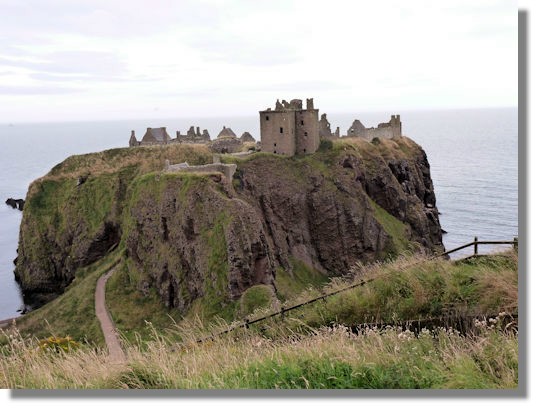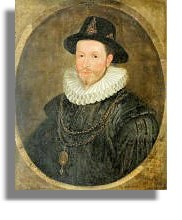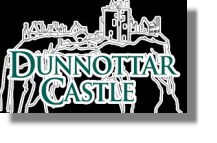
Dunnottar Castle, Aberdeenshire
Places to Visit in Scotland
- Dunnottar Castle, Aberdeenshire
Location
Dunnottar Castle is on the coast of Aberdeenshire about 2 miles south of Stonehaven. It stands on a promontory jutting out into the sea on the top of cliffs rising 160 feet from the sea. The spectacular location brings over 40,000 visitors each year to view this impressive ruin. A narrow strip of land joins the headland to the mainland, with a steep path leading up to the gatehouse.
Early History
Because of its site which made it easy to defend until the invention of canons, it is likely that some kind of fortification has stood on this site for over 1,000 years - although as these would be wooden buildings no trace of them remains.It is believed that one of the earliest Christian churches in the area controlled by the Picts was established here in the 5th century and became known as St Ninian's church. Later, a Pictish fort was built on the site and was defended by King David II. A stone church building in the style of Norman churches was created and became St Ninian's chapel. It was attacked by the Vikings in 900AD and the Scottish king Donald was killed.
Over the centuries many buildings were created on the site, including an L-plan tower which has been dated as early 15th century, with four storeys with a basement kitchen and cellars and a hall on the first floor and the main hall on the second floor. Other buildings within the castle include a 14th-century tower house as well as a palace from the 16th-century. Twelve of the structures on the site created on this cliff-top village are listed as buildings of "national importance". The graphic on the left of Dunnottar from the air is © Scotavia.
By the 16th and 17th centuries a wall had been constructed round a large courtyard (which had a bowling green) and there were private chambers, a large chapel, barracks and a house for a priest.
William Wallace captured Dunnottar from the English in 1296 but it was occupied again by the English in the 1330s who tried to strengthen its defences but Sir Andrew Murray recaptured it soon after.
The long association of the Keiths with Dunnottar began in 1382. when it was exchanged for another castle in Fife with Lindsay of the Byres. William Keith, 5th Earl Marischal, and founder of Marischal College in Aberdeen (see portrait on the right) then left his mark. His fortifications meant that he removed an early church which resulted in his excommunication by the Pope but was reinstated after building another chapel on a better location! The entrance is defended by a steep track with three tiers of defensive walls. Another access was via a cave-like tunnel cut into the rock itself.Mary Queen of Scots who ranged far and wide across her realm stayed at Dunnottar in 1562. The 9th Earl Marischal entertained King Charles II at Dunnottar in 1650 and 1651. The drawing below shows the castle as it was in 1645. But when the Earl Marischal sided with the Jacobites in 1715 the castle was forfeited and was largely destroyed by the Duke of Argyll soon after.

Dunnottar Castle About 1645
Rescue of the Honours of Scotland in 1652
Dunnottar is not only famed for its impressive location and history but also for helping to keep the "Honours of Scotland" from the hands of the invading army of Oliver Cromwell during the Civil War which enveloped the United Kingdom in the middle of the 17th century.
The "Honours of Scotland" are the crown jewels of the Kingdom of Scotland and consist of a crown, a sword and a sceptre. The crown was first used by King James V at the coronation of his second queen, Mary of Guise (mother of Mary Queen of Scots).
They were also used at the coronation of King Charles II at Scone on 1 January 1651. But during the occupation of Scotland by Oliver Cromwell, during Puritan times, the jewels were hidden for safety in Dunnottar castle. When Oliver Cromwell´s army besieged the Castle the defenders managed to hold out for eight months. A combination of starvation and heavy cannons arriving in 1652 resulted in its capture on 24th May that year.
But during the siege the Scottish crown jewels were spirited away by the wife of the minister at nearby Kinneff church who persuaded the head of the Cromwellian forces to allow her to visit one of the ladies in the castle - using the argument that "English gentlemen did not wage war on women." While in the castle she hid the crown jewels under her clothes and those of a lady servant and although looking more like an expectant mother than an elderly woman, she was able to smuggle them back to the church. They were hidden under the pulpit where they remained until the restoration of the monarchy in 1660.Under the terms of the Treaty of Union in 1707, Scotland's crown jewels were retained in Edinburgh castle where they still remain on show.
Current Owners
The Castle was bought in 1925 by the family of the industrialist Weetman Pearson who became Viscount Cowdray in 1917. The 1st Viscountess, Lady Cowdray, began a program of urgently needed restoration and thereafter opened the Castle to the public in the Summer Season (nowadays 1st April - 30th Sep). Postcode (useful also for satnav) is AB39 2TL. See also Dunnottar Castle

Dunnottar Castle








